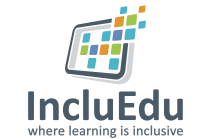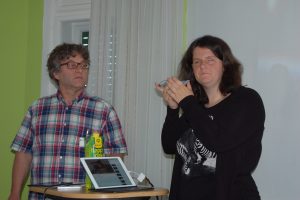WHAT DID YOU DO?
First she had to learn how to handle the device as a blind user. Therefore she uses the built in screen reader “Voice over”. With this feature she can hear a description of everything that is happening on her screen, from battery level to which app her finger’s on. She just touches the screen to hear what’s under her finger and then uses gestures to control the device. Additionally she uses the built in voice control feature “Siri”. With Siri she can send messages, write mails or schedule meetings. Because Siri is integrated with Voice Over, she can for example ask where the nearest pizzeria is and hear the answer read out loud.
First she had to learn how to handle the device as a blind user. Therefore she uses the built in screen reader “Voice over”. With this feature she can hear a description of everything that is happening on her screen, from battery level to which app her finger’s on. She just touches the screen to hear what’s under her finger and then uses gestures to control the device. Additionally she uses the built in voice control feature “Siri”. With Siri she can send messages, write mails or schedule meetings. Because Siri is integrated with Voice Over, she can for example ask where the nearest pizzeria is and hear the answer read out loud.
HOW DID YOU DO IT?
For her learning Sandra uses her mobile device in different ways.
- To support her mobility
- She uses an app called “qando Graz” that allows her to find the next bus stop and the departure times of the next bus.
- To support her communication
- She just writes and sends mails with Siri or uses the dictation function that is built-in in iOS.
- To support her perception
- She uses an app called “TapTapSee” that allows her to take pictures of an object and get an auditory feedback (i.e. at university she takes a picture of a door number to know which room it is - the number will be read aloud)
- To be up to date
- She uses an app of an Austrian newspaper called “iStandard”. Again the text-to-speech function of her iPhone reads out loud whats on the news.
- To support her studies at University
- She uses as app about Austrian Law called “Gesetze Österreich” and “RIS”
For her learning Sandra uses her mobile device in different ways.
- To support her mobility
- She uses an app called “qando Graz” that allows her to find the next bus stop and the departure times of the next bus.
- To support her communication
- She just writes and sends mails with Siri or uses the dictation function that is built-in in iOS.
- To support her perception
- She uses an app called “TapTapSee” that allows her to take pictures of an object and get an auditory feedback (i.e. at university she takes a picture of a door number to know which room it is - the number will be read aloud)
- To be up to date
- She uses an app of an Austrian newspaper called “iStandard”. Again the text-to-speech function of her iPhone reads out loud whats on the news.
- To support her studies at University
- She uses as app about Austrian Law called “Gesetze Österreich” and “RIS”
WHY WERE TABLETS USED/WAS IT BENEFICIAL?
She never thought that a blind person could use a device with touch screen. During her years in secondary school she used computers with a screen reader program and a braille display. And then a blind friend of her told her about the advantages of using iPhones with the built in function “Voice Over” and so she got her first iPhone in 2010 and it really made a big change in terms of accessibility and usability. Since then it is much easier for her to have access to information (i.e. to read newspapers with an app) and communicate with others. In the meantime lots of blind users use these devices. One very positive aspect is that it is a “normal” device which is well known by everybody. A teacher and his blind student may have the same device – they just use different functions. There is no special software needed – Voice Over is accessible for everybody and is integrated in the operation system of the device. For a teacher (especially if he/she is not a support teacher) it is much easier and more familiar to teach a blind learner who is using his iPad.
She never thought that a blind person could use a device with touch screen. During her years in secondary school she used computers with a screen reader program and a braille display. And then a blind friend of her told her about the advantages of using iPhones with the built in function “Voice Over” and so she got her first iPhone in 2010 and it really made a big change in terms of accessibility and usability. Since then it is much easier for her to have access to information (i.e. to read newspapers with an app) and communicate with others. In the meantime lots of blind users use these devices. One very positive aspect is that it is a “normal” device which is well known by everybody. A teacher and his blind student may have the same device – they just use different functions. There is no special software needed – Voice Over is accessible for everybody and is integrated in the operation system of the device. For a teacher (especially if he/she is not a support teacher) it is much easier and more familiar to teach a blind learner who is using his iPad.
HOW DID IT SUPPORT INCLUSIVE TEACHING?
In teacher training Sandra shows how she is using her iPhone or iPad to demonstrate that the way how blind learners use it, is not that special or different from other users. Nowadays most of the blind learners in Austria attend the local school and they and their teacher get support from special educated support teachers. Sandra supports these teachers as an expert.
In teacher training Sandra shows how she is using her iPhone or iPad to demonstrate that the way how blind learners use it, is not that special or different from other users. Nowadays most of the blind learners in Austria attend the local school and they and their teacher get support from special educated support teachers. Sandra supports these teachers as an expert.




